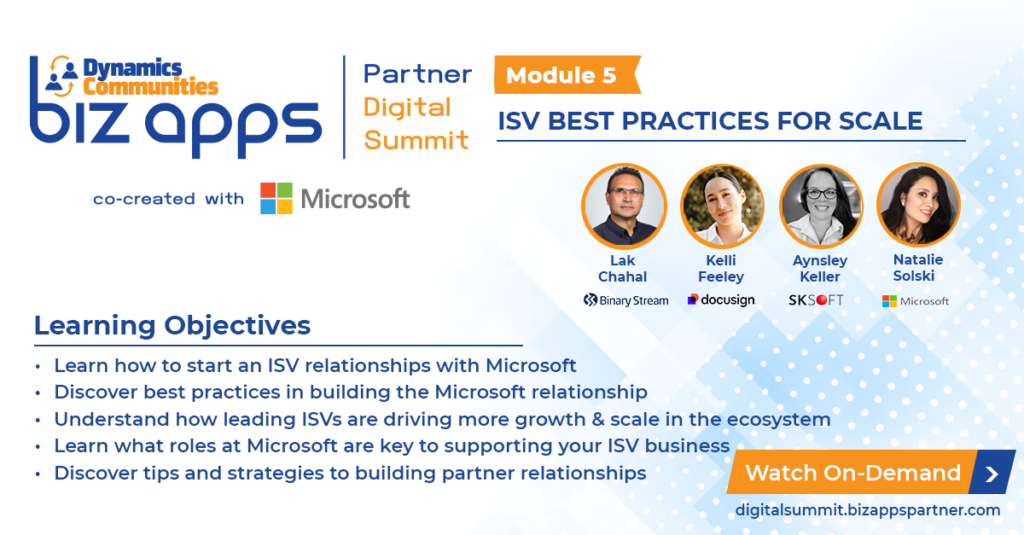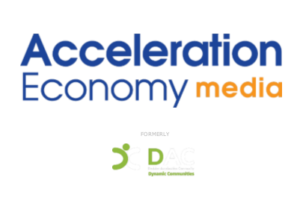Biz Apps Partner Digital Summit: Best Practices for ISVs in the Microsoft Ecosystem

Developed by Microsoft and Dynamics Communities, each of the five modules of the Biz Apps Partner Digital Summit delivers executive insights, plans, and ideas that System Integrators (SI’s) Consultants, and Independent Software Vendors (ISVs) can put to work for their business. Each module features Microsoft leadership explaining the “why” behind these initiatives and programs, and business applications partners defining how they’ve successfully been put to work.
Module 5 of the Biz Apps Partner Digital Summit, “ISV Best Practices for Scale,” featured Microsoft’s Natalie Solski leading a panel discussion with ISVs Aynsley Keller, Chief Operating Officer, SKsoft, Lak Chahal, President & CEO, Binary Stream, and Kelli Feeley, Director, Business Development, Docuign, that are setting the pace within the Business Applications ecosystem where they discussed, debated, and defined the best practices that create Microsoft relationships, scale customer opportunities and build partner relationships.
Strategies for Becoming a Top ISV in the Microsoft Ecosystem
Chahal explained that Binary Stream, who has been an ISV in the biz apps space for nearly 25 years, evolved from the GP space to cloud solutions and, specifically, Dynamics 365, following Microsoft’s shift in direction. To thrive as an ISV in this space, Chalal advised two things:
- Work closely with Microsoft to understand the entire ecosystem
- Forging strong relationships with other ISVs
“I think this is very critical in the sense that there is a lot of learning involved, right? So, I think one thing I strongly recommend is to really put your energy into understanding the ecosystem,” Chalal expressed.
Feeley added that a critical tactic for scaling as an ISV in the Microsoft ecosystem is to “start from the top” and set “executive alignment up front,” so the partnership has a strategic vision to act on. Once aligned internally, it’s about “identifying who your internal and Microsoft stakeholders are in order to really create and execute that strategic vision together that really meets your partnership goals as well as your customer needs.”
Keller explained how SKsoft has emerged as a differentiated leader in banking and treasury across the Dynamics platforms, which is segmented into three key areas of focus:
- Emphasis on product
- More time spent listening than “pivoting”
- Get an internal admin to manage and add data to Partner Center
Internally Structuring Microsoft Relationships
Keller explained SKsoft’s philosophy on maintaining its relationship with Microsoft: “We really teach every manager, every employee, even newer employees, that are coming into our organization, that everybody can impact the alliance with Microsoft, whether that’s good or bad.” On a higher level, she described how SKsoft emphasizes the value of staying engaged with Microsoft, ensuring the company is “speaking the same language” as them, and that “it’s not segmented based on the department or the role that you have in the company.”
Freeley agreed with Keller’s idea that everyone in the company has a stake in its relationship with Microsoft, which holds particularly true for Docusign. For Docusign, the core teams involved with Microsoft are product, marketing, and sales, then “going from the top down.” She stressed that “seller engagement is absolutely paramount, and especially in the early days, that’s kind of the time to build that co-sell motion into your company’s DNA.”
Chahal shared who on the Binary Stream team is actively involved with Microsoft, including account executives, solution consultants, marketing and innovation teams, and finance executives. He added that one thing to consider is that “Microsoft is huge and complex… make sure you keep up with the different roles.”
Programs for ISV Success
Chalal detailed the Microsoft programs that have helped Binary Stream excel as an ISV in the ecosystem, such as Microsoft FastTrack. The FastTrack program leverages Microsoft’s best practices to assist enterprises and SMCs in various areas, including subscription management and order to cash. It aligns with Microsoft’s incentives to minimize costs for migrating customers to Business Central or Finance & Operations, providing significant savings and benefits, especially for smaller companies.
SKsoft has leveraged programs and benefits like Microsoft Internal Use Rights (IUR), Visual Studio licenses, and Azure DevOps (ADO) pieces, which are beneficial for ISVs who align with Microsoft’s best practices and obtain necessary certifications. When evaluating Microsoft programs or incentives, Keller explained that it’s crucial to ensure they do not disrupt partner success.
Feeley urged ISVs to be “Azure Marketplace ready” if not already.
“This is Microsoft’s key initiative that not only their sellers are incentivized to engage with you, but Marketplace also provides direct advantages for customers and partners alike.” Further, The Microsoft AI Cloud Partner Program (MAICPP) offers immediate benefits, including monetary rewards that can be reinvested into go-to-market activities and marketplace rewards such as asset creation, enablement sessions, and marketing offerings like customer success stories and executive endorsements.
Best Practices for Emerging ISVs
For ISVs newer to the process, Feeley explained that there are so many recommendations and guidance to give, but she suggested to “start small. It’s really easy to get overwhelmed, and feel pressure to do everything at once, so just do your research, absorb as much information as you can.”
“This ecosystem is all about relationships… you need to have a good plan to navigate through all the sections of Microsoft, whether it’s Partner Center you’re looking at, whether you look at competencies, whether you’re looking at transactability, and be able to drive [that] closer relationship,” noted Chahal.
Keller explained that ISVs “don’t have to guess [their] way through it.” Microsoft programs are well documented and many other ISVs in the ecosystem are more than willing to share their experiences.
“While things have changed over the 30 years that SKsoft has been doing this, we’ve learned a lot. We’ve made a few mistakes. We’ve learned from those so that you don’t have to learn from them yourself. So, I just say, reach out, go to the conferences, you know, talk to other ISVs, ask what they’re doing, ask us what we’re doing. And I think we’ll all be the greater for it.”


